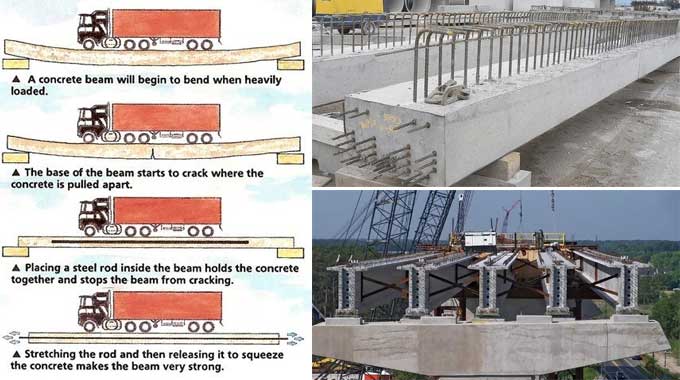NEWS | SOFTWARE | SHEET
Types and Benefits of Prestressed Concrete in Construction
PSC stands for pre-stressed concrete. Steel and concrete are used to make ordinary reinforced concrete, which carries compressive and tensile stresses. Due to its weak tension strength, concrete around steel is unable to support tension.
Concrete is useful for resisting compressive stresses of that portion that is above the neutral axis. Concrete that has been pre-stressed provides a dynamic balance between the pre-compressive and stress-strain forces due to the external loads.
This is achieved by introducing internal stresses of a suitable magnitude and distribution during the construction process. The concrete as a whole is able to resist external forces because of this property. When pre-stress is imposed on reinforced concrete members, the steel reinforcement is commonly tensed.
Material of Pre-Stressed Concrete
- The steel of high tensile strength.
- Highly durable concrete.
Wires made from ordinary mild steel do not have to pre-stress after losses, so they are not useful. Various losses cause the initial tensile strain in steel to be reduced by up to 20% after tensioning. A block of good-quality concrete used in PSCs. Well-compacted concrete is less elastic and shrinks less plastically, leading to a reduction in pre-stressing loss.
Types of Prestressed Concrete
A pre-stressed concrete structure can be classified into several different useful ways.
A. Full pre-stressing and partial p-test
The concrete should be pre-stressed if there is no tensile stress. Under normal workload conditions, concrete produces some tensile stresses. It has been partially pre-stressed.
B. Pre Tensioning and Post Tensioning System
Pre-tensioning is a method of pre-tensioning the tension before the concrete lies. Post-tensioning systems consist of steel or tubular members that make up concrete or metal ducts. Concrete members anchored at their ends are tensioned and anchored at their ends once they are sufficiently hard.
C. Linear or Circular pre-stressing
Applied to straight members, such as beams, slabs, and piles, linear pre-stressing ensures uniform tension. It involves tendons that extend around the circumference of circular structures, like tanks, pipes, and silos.
D. External or Internal pre-stressing system
External pre-stressing occurs when external reactions are introduced through the support conditions.
Benefits of Prestressed Concrete
It is used in construction with dynamic loads, including rail bridges, machine foundations, and long-span floors. Construction uses precast pre-stressed concrete. In these members, shear forces are more resistant.
The technical advantages of this construction method are significant. Pre-tensioned members that are capable of withstanding tensile loads are more effective. RCC is inferior to composite materials.
Uses of Prestressed Concrete
- The long span bridge.
- Buildings of great height.
- Slabs with hollows.
- Box girders for simple spans.
- Bridges made of cable.
- Floors with flat slabs.
To get more clear ideas, go through the following exclusive construction video tutorial.
Lecturer: Engineering Motive
Properties of Prestressed Concrete
- Materials are saved since the members are lighter.
- Members of this group tend to be more economical than members of the R.C.C.
- Shearing forces are less easily applied to it because of its improved resistance.
- Stiffness of Pre-stressed Concrete is greater than that of Reinforced Concrete.
Recommended Articles:
Difference between Pretension and Post Tension


